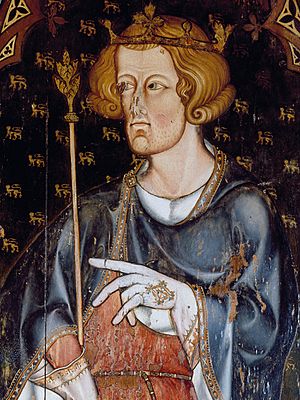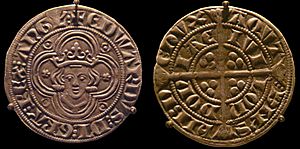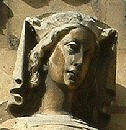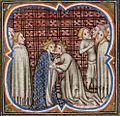Edward I of England facts for kids
Quick facts for kids Edward I |
|
|---|---|

Portrait in Westminster Abbey probably depicting Edward I, installed during his reign
|
|
| King of England (more...) | |
| Reign | 20 November 1272 – 7 July 1307 |
| Coronation | 19 August 1274 |
| Predecessor | Henry III |
| Successor | Edward II |
| Born | 17/18 June 1239 Palace of Westminster, London, England |
| Died | 7 July 1307 (aged 68) Burgh by Sands, Cumberland, England |
| Burial | 27 October 1307 Westminster Abbey, London |
| Spouse | |
| Issue more... |
|
| House | Plantagenet |
| Father | Henry III of England |
| Mother | Eleanor of Provence |

Edward I (born 17 June 1239, died 7 July 1307) was a Plantagenet King of England. He was also known as Longshanks because of his height, and the Hammer of the Scots. He became king on 21 November 1272 and ruled until his death in 1307.
Edward was the son of King Henry III of England and Queen Eleanor of Provence. When he was younger, he fought to protect his father's rule during a civil war. He also went on a Crusade to the Holy Land.
As king, Edward made many important changes. He improved England's laws and made Parliament a regular and powerful part of government. He conquered Wales and brought it under English control. He also tried to control Scotland, often by choosing who would be king there. During his reign, he ordered all Jewish people to leave England.
Contents
Young Edward's Life
Edward was born in Westminster in June 1239. He was named after an earlier king, Edward the Confessor. He received a good education. His mother, a French princess, loved art, and his father, the king, was interested in history. Edward learned to speak Latin and French.
In 1254, when Edward was 14, he married Eleanor of Castile. She was the half-sister of King Alfonso X of Castile. This marriage helped ease fears of an invasion from Castile into the English area of Gascony.
As part of the marriage, Edward received large areas of land. These included parts of Ireland, Wales, and England. However, his father, the king, still kept most of the control and income from these lands. This meant Edward did not have much power on his own at first.
Civil War in England
From 1264 to 1267, England faced a civil war called the Second Barons' War. Powerful nobles, led by Simon de Montfort, fought against King Henry III. Edward supported his father.
Edward fought bravely in battles. At the Battle of Lewes in 1264, he defeated some of de Montfort's forces. But he chased them too far, and when he returned, the rest of the king's army had lost. Edward was captured and held prisoner.
He managed to escape in May 1265. He then joined forces with the Earl of Gloucester, who had switched sides to support the king. Edward quickly recaptured important towns.
The war ended at the Battle of Evesham on 4 August 1265. Edward's forces were much stronger than de Montfort's. Simon de Montfort was defeated and killed in the battle. Edward continued to fight against other rebels until peace was fully restored.
Crusade and Becoming King
In 1268, Edward decided to go on a Crusade to the Holy Land. He joined his brother and cousin in this journey. It was hard to raise enough money for the trip.
Edward finally arrived in Acre in May 1271. The Christian lands there were in danger from Muslim armies. Edward tried to help, but the situation was very difficult. He even survived an attack by an assassin.
Edward left Acre in September 1272. While he was traveling back, he received sad news. His father, King Henry III, had died on 16 November 1272. Edward was now the King of England.
He took his time returning home. England was peaceful, and a royal council governed the country until he arrived. Edward traveled through Italy and France, dealing with some issues in Gascony. He finally returned to England on 2 August 1274. He was crowned King on 19 August.
Edward's Reign as King
King Edward's time as ruler had two main parts. First, he focused on making England peaceful and well-governed. Second, he led wars against Wales and Scotland.
Governing England
Edward's first goal was to bring order back to England. His father's reign had been difficult. Edward appointed new officials, including Robert Burnell as his main advisor, the Lord Chancellor. He also replaced many local officials, like the sheriffs.
He created new laws to help people understand their rights. These laws covered things like owning land, collecting debts, trade, and keeping peace in local areas.
Parliament's Power
Edward made the English Parliament much more important. He held Parliament meetings regularly. In 1295, a big change happened. For this Parliament, Edward called not only the lords but also two knights from each county and two representatives from each town.
Before, these common people were just expected to agree to decisions already made by the rulers. Now, they came with the full power of their communities. This meant they could truly agree to decisions made in Parliament. This helped the king collect taxes from everyone in the country. Historians call this the "Model Parliament."
Wars in Wales
Llywelyn ap Gruffudd was the main leader in Wales. He refused to show loyalty to Edward. In November 1276, Edward declared war on Wales.
In July 1277, Edward invaded Wales with a large army. Llywelyn soon realized he could not win and surrendered. By the Treaty of Aberconwy, Llywelyn was left with only a small area of land. He was allowed to keep his title of Prince of Wales.
War broke out again in 1282. This time, it was a fight for Welsh national identity. Many Welsh people supported the rebellion. Edward saw this as a war to conquer Wales completely. Llywelyn was killed in battle in December 1282. His brother, Dafydd, was captured and executed as a traitor in 1283.
With the Statute of Rhuddlan in 1284, Wales became part of England. It was given an English-style government. Edward also started building new towns like Flint and Rhuddlan.
Edward also built many strong castles to control the Welsh. These castles used new designs, like concentric walls, which were inspired by his time on Crusade. In 1284, Edward's son, also named Edward, was born at Caernarfon Castle. This son later became King Edward II of England. In 1301, he was given the title of Prince of Wales, a tradition that continues today.
Wars with Scotland
Scotland and England were peaceful in the 1280s. But then, King Alexander III of Scotland died in 1286. His granddaughter, Margaret, who was supposed to be queen, also died in 1290. This left Scotland without a ruler.
The Scottish Crown
Fourteen people claimed the Scottish throne. The two strongest claims were from John Balliol and Robert de Brus. The Scottish leaders asked Edward to decide who should be king. In 1292, Edward chose John Balliol.
Edward continued to act as if he was the overlord of Scotland. He interfered in Scottish laws and demanded Scottish soldiers for his army. This made the Scots angry. They made an alliance with France and attacked the English town of Carlisle.
Edward responded by invading Scotland in 1296. He captured the town of Berwick in a very bloody attack. At the Battle of Dunbar, Edward crushed the Scottish army. He took the Stone of Scone (Scotland's coronation stone) to Westminster. He removed Balliol from the throne and put English officials in charge of Scotland.
William Wallace and Robert the Bruce
The English victory was short-lived. William Wallace, a Scottish leader, started a new rebellion. He defeated a large English army at Stirling Bridge in 1297. Edward was away at the time.
In 1298, Edward returned and defeated Wallace at the Battle of Falkirk. After this, the Scots avoided big battles. They used small groups to raid England instead.
In 1303, England and France made a peace agreement. This broke the alliance between France and Scotland. Many Scottish nobles then swore loyalty to Edward. William Wallace was captured and publicly executed.
But the conflict started again in 1306. Robert de Brus, the grandson of the earlier claimant, murdered his rival and crowned himself King of Scotland. Edward, who was old and sick, sent armies north. Robert the Bruce was defeated in battle. Edward then punished Bruce's supporters very harshly. This only made more Scots rebel. The war was still going on when Edward died in 1307.
Family Life
Edward's first wife, Eleanor of Castile, died on 28 November 1290. They loved each other very much, which was unusual for royal marriages at the time. Edward was very sad when she died. He built twelve special stone crosses, called Eleanor crosses, at each place where her funeral procession stopped.
In 1299, Edward married Margaret of France as part of a peace agreement with France.
Edward and Eleanor had at least 14 children. Five of their daughters lived to be adults. But only one son, the future King Edward II, lived longer than Edward. Edward was sometimes worried that his son was not living up to his expectations.
Images for kids
-
Edward I (right) showing loyalty to Philip IV of France (left). As the ruler of Aquitaine, Edward was a vassal (a lord who serves a king) of the French king.
-
King Edward's Chair in Westminster Abbey. The Stone of Scone used to be kept under the seat.
-
Bishop William Stubbs, a historian, wrote about Edward I's important role in shaping the English government.
-
The concentric (walls within walls) design at Beaumaris Castle.
See also
 In Spanish: Eduardo I de Inglaterra para niños
In Spanish: Eduardo I de Inglaterra para niños












